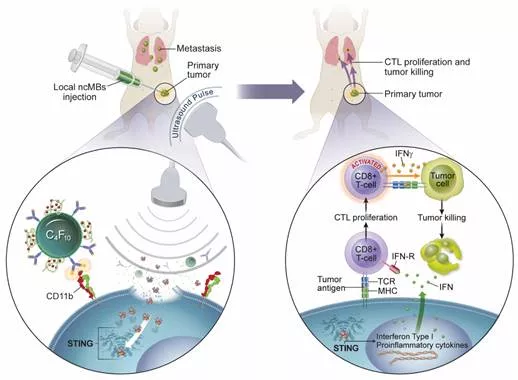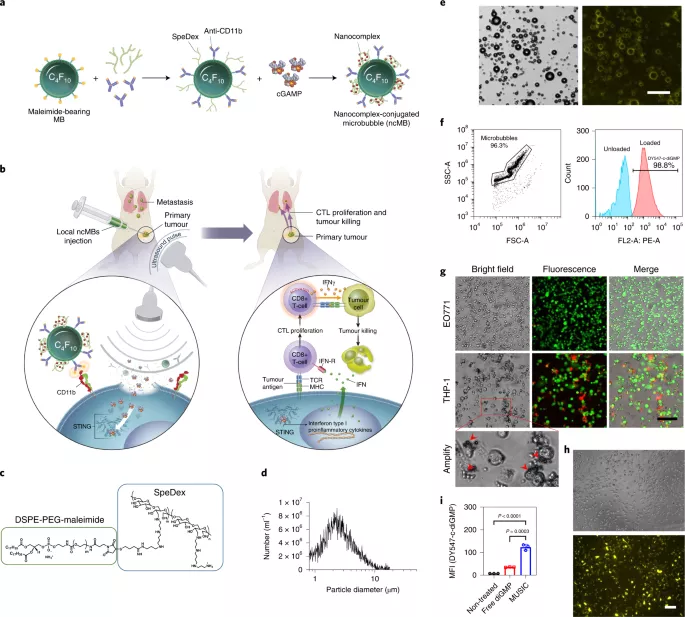According to new atlas, microbubbles and ultrasound seem to be a strange combination, but recently researchers have seen that the combination of these two forces has had a huge impact on the medical community A newly developed treatment method uses these tools to deliver immunotherapeutic drugs, and the effect is very good, which greatly slows down the tumor growth in the mouse model of breast cancer

This new technology, developed by scientists at the University of Texas Southwestern Medical Center, is called "microbubble assisted ultrasound-guided cancer immunotherapy" (Music), and adds new content to more and more exciting technologies in this field. These technologies include using microbubbles to pressurize ultrasound for clearer cardiac imaging, deploying microbubbles to pry open the blood-brain barrier and provide Alzheimer's drugs, or bringing lasers into the mixture to crush arterial plaques.
Researchers have also seen promising progress in cancer treatment. One method is to inject tiny bubbles filled with gas into the tumor and use ultrasound to detonate them, causing mechanical pressure to remove the cancer cells. Another method is to use ultrasound to target the tissue and generate tiny bubbles from the outside, which may prove particularly useful for the treatment of inaccessible tumors.
The creators of music technology describe it as the first of its kind. One difference is that it is designed to deliver drugs rather than kill cancer cells by violent destruction. However, this is not to say that mechanical pressure does not work. As Jacques lux, the co-author of the study, explained, ultrasound is used to make small openings in the cell membrane so that drugs can enter.

"When exposed to an ultrasonic field, microbubbles oscillate. If these microbubbles combine with cells when exposed to a sufficiently high ultrasonic intensity, the oscillation will push and pull the cell membrane. This creates pores and opens the door for microbubble goods to enter the cell membrane," he said
The team's system consists of microbubbles loaded with cyclic dinucleotide cgamp, a natural agent that triggers an enhanced immune response to tumors by activating a pathway called CGAs sting. Cgamp delivery methods are hampered by poor stability and slow entry into cells, but the team believes that its new platform has solved these problems.
Microbubbles also carry antibodies that help them target certain immune cells called antigen-presenting cells (APCs). Due to the cell membrane oscillation induced by ultrasound, cgamp can penetrate APCs more effectively and activate CGAs sting pathway. This in turn provides the impetus for the attack of immune T cells, and then targets them and destroys tumor cells.
This is the first time that scientists can directly deliver cgamp to APCs. In the triple negative breast cancer experiment of mouse model, it is found that this technology can significantly reduce the growth of tumors. 60% of the treated mice experienced complete tumor eradication. At the same time, the technology also produced anti-tumor memory in T cells, which helped to prevent tumor recurrence.
In a separate experiment on the mouse model of metastatic breast cancer, the research team found that this technology can target the primary tumor, activate a strong T cell response, see the "long journey" of cells, and deal with cancer lesions in different parts of the body. Adding a common immunotherapy drug to the combination in the form of PD-1 blocker can further prevent the development of the disease. The median survival rate of this combination therapy was 76% higher than that of PD-1 blocker alone.
"We injected our microbubbles into the primary tumor, applied ultrasound, and found that metastatic tumors -- such as those in the lungs -- were disappearing," lux said
When the team focused on the clinical deployment of this technology, it was advantageous that microbubbles had been widely used as a contrast agent for ultrasonic imaging. Music technology also seems to be low toxic, and scientists believe that its high targeting can help avoid some of the extensive inflammation associated with other cgamp delivery methods.
Lux said: "ultrasound scanners are more affordable than other imaging methods, and they are available in all hospitals in the United States. It will be exciting to have a relatively inexpensive, image-guided treatment method that can be used to improve the treatment of cancer patients."
The study was published in Nature Nanotechnology 》In magazines.